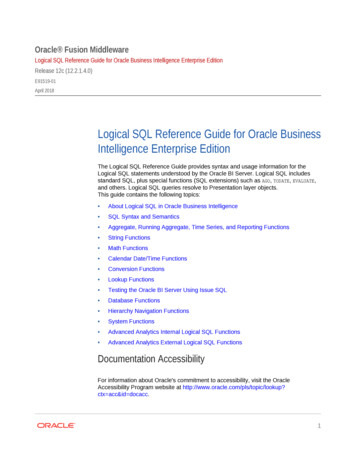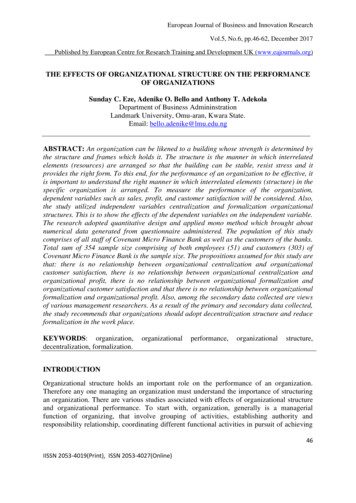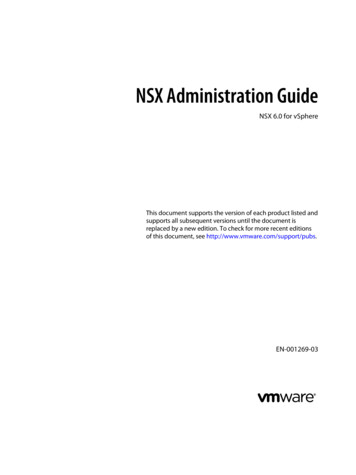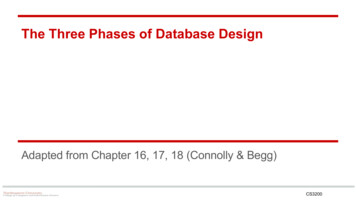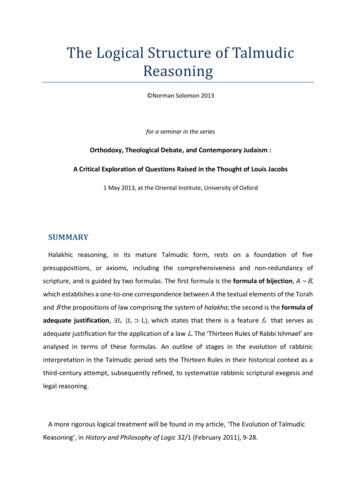
Transcription
The Logical Structure of TalmudicReasoning Norman Solomon 2013for a seminar in the seriesOrthodoxy, Theological Debate, and Contemporary Judaism :A Critical Exploration of Questions Raised in the Thought of Louis Jacobs1 May 2013, at the Oriental Institute, University of OxfordSUMMARYHalakhic reasoning, in its mature Talmudic form, rests on a foundation of fivepresuppositions, or axioms, including the comprehensiveness and non-redundancy ofscripture, and is guided by two formulas. The first formula is the formula of bijection, A B,which establishes a one-to-one correspondence between A the textual elements of the Torahand B the propositions of law comprising the system of halakha; the second is the formula ofadequate justification, fx (fx L), which states that there is a feature fx that serves asadequate justification for the application of a law L. The ‘Thirteen Rules of Rabbi Ishmael’ areanalysed in terms of these formulas. An outline of stages in the evolution of rabbinicinterpretation in the Talmudic period sets the Thirteen Rules in their historical context as athird-century attempt, subsequently refined, to systematize rabbinic scriptural exegesis andlegal reasoning.A more rigorous logical treatment will be found in my article, ‘The Evolution of TalmudicReasoning’, in History and Philosophy of Logic 32/1 (February 2011), 9-28.
On the Nature of Talmudic ReasoningLouis Jacobs devoted much of his scholarly output to what he called the Talmudicargument, and made significant contributions to our understanding of the literaryconstruction of the Talmudic sugya. I should like to record my personal gratitude to him asone of the first to take an interest in my own work on the Analytic School associated withthe name of Ḥayyim Soloveitchik and to offer some helpful suggestions andencouragement. I offer this piece in his memory.The Rabbinic ProjectModern readers of the Talmud – even yeshiva students – are apt to lose patience with thearguments that fill so many of its pages about how this, that or the other rabbi read this, that or theother verse to support this, that or the other halakhic ruling. But obviously the rabbis themselveswere greatly exercised about such matters, to the extent of erecting an elaborate edifice of rules tojustify their readings, and engaging in a major project to demonstrate that the system of law theyhad articulated corresponded perfectly with the biblical texts of which they believed themselves thefaithful guardians.They formalized their inferential techniques, but did not create an abstract system of reasoning ofgeneral application as Aristotle had done, nor would they have wished to create one; such logic asthey had was ancillary to the sacred activity of Torah study, not an end in itself.One of my amusements when I was a philosophy undergraduate was to recast a newspaper articlein the form of Aristotelian syllogisms. This never demonstrated that writer’s thesis was correct, but itdid show that if you choose your axioms or premises skilfully you can make anything appear rational.What I shall attempt in this exercise is to clarify the axioms and premises that lie behind the rabbinicsystem of relating halakha to scripture. My description in logical terms of what they were doing willilluminate the underlying logical structure of their reasoning processes, but it will not say anythingabout their conscious intentions, still less about the objective validity of their conclusions.We should not assume that all rabbinic reasoning is of a consistent pattern, or that it conforms tothe ‘Thirteen Rules of Rabbi Ishmael’ which I shall discuss later; nor should we assume that RabbiAqiva, in second-century Palestine, argued with the same methods or on the same set ofassumptions as Abbaye and Rava in fourth-century Babylonia.1 Page
I shall restrict my remarks to halakhic argument. Aggada often enough utilizes the same forms, butalso engages in free word associations, narrative exegesis and imaginative flights of fancy. Even withregard to halakha I will not offer any account of non-logical aspects of discourse, for instance of thesociological or the psychological assumptions made by the rabbis, interesting as these are.The First Three Presuppositions (Axioms)James Kugel [12] has listed four assumptions on which, he claims, ancient interpreters such as BenSira worked:1. The Bible is cryptic - its real meaning is not apparent.2. It is a single great Book of Instruction, fundamentally relevant.3. It is perfect and harmonious, free from mistakes or inconsistencies, ‘omnisignificant’.4. It is divinely sanctioned and inspired.The rabbis flatly contradict the first of these assumptions, at least in the context of halakha – thereal meaning is apparent, provided you know how to read; Torah is not esoteric. They also narrow‘Bible’ by privileging the Five Books of Torah (though the rest is consistent and divinely inspired),which they maintain were not merely ‘inspired’ by God but dictated verbally to Moses.Their assumptions are:1. The Torah is free from error.2. There is nothing redundant in the Five Books of the Torah—every word, every nuance, tellsus something, or is required by the structure of the Hebrew language.3. The Five Books are comprehensive, containing all that humans need to know, or at least allthey need to know to conduct their lives in accordance with God’s will.None of these assumptions is stated in scripture, nor are they anywhere listed as a group withinthe rabbinic corpus. The perfection of Torah is a constant rabbinic theme. That it is free fromredundancy is an explicit and unchallenged teaching of the School of Rabbi Ishmael in the Bavli:11 לא נישנית אלא בשביל דבר שנתחדש בה , כל פרשה שנאמרה ונישנית : תנא דבי רבי ישמעאל Sota 3a, BQ 64b, Shavu’ot 19a, Menaḥot 10a, Bekhorot 43b.2 Page
From a logical point of view, the sentences expressing the assumptions articulate three axioms of arabbinic theory of interpretation. They are three sentences belonging to the set of sentences thatcomprise the theory and, as axioms, are included without proof.2Let us set out the three axioms formally:Axiom 1: Scripture is free of error.That is:For any statement S, if S is a statement in scripture, S is true.Axiom 2: No scriptural expression is redundant.Or:For any expression E, if E is an expression in scripture, E conveys a unit ofinformation, and there is no expression E1 that conveys the same unit ofinformationThe ‘unit of information’ should be understood as ‘unit of the Torah’s system of law’, or ‘memberof the set of laws of the Torah’. It is immaterial for our purposes whether ‘unit of law’ is thought ofin ontological terms (the reification of law) or as ‘proposition of law’; either way, it is distinct fromthe sentences and expressions of the written Torah.Axiom 3: Scripture is comprehensive.That is:For any unit of information i, if i B, there exists an expression E in scripture thatpoints to itAgain, ‘unit of information’ is understood as ‘unit of the Torah’s system of law’2That is, no proof within the system. The demonstration e.g. that the text is a perfect transcriptionof God’s words is not relevant to argumentation within the system, but functions as a theologicaljustification, external to the system itself, and is therefore not included among the axioms.3 Page
Basic StructuresThe logical structure of the rabbis’ hermeneutic of the Talmudic can be exhibited in terms ofrelationships within and between two sets (‘classes’, ‘groups’, or ‘domains’).Set A is the set of sentences, terms, expressions in the written Hebrew text of the Torah, i.e. theFive Books from Genesis to Deuteronomy.Set B is the full set of laws (i.e., propositions, or reified laws, but not the written texts) comprisingthe Torah.These sets are collections of items (texts, laws). These items lack characteristics beloved ofmathematicians, such as recursive enumerability, strict order or well-foundedness, though selfreference is certainly possible, as when the Torah says ‘This is the Torah that Moses set before theIsraelites’3. To put it another way, unlike e.g. the set of real numbers, where the whole set can begenerated from one number by a simple algorithm, the items in these sets cannot be generatedfrom one another; they are more like random collections.Set A has the following characteristics:1. It is finite and enumerable; the whole text is ‘out there’2. It is constrained by the rules and structures of natural language3. It is hierarchical, ranging down through books, pericopes,4 sentences, phrases, words,individual letters and their shapesSet B has these characteristics1. It is finite and enumerable, consisting of the body of law revealed to Moses at Sinai2. It is often possible for a specific law (for instance, ‘do not steal’) to take the form of asubset of laws comprising a small, definable group of members3. Relations between laws can sometimes be established on the basis of ‘second-order’principles that govern more than one law3Deuteronomy 4:44. In fact this is not a true self-reference, but a reference to the laws comprisedin chapters 12-26 (see Rashi ad loc.), but the logical point remains.4The familiar chapter divisions postdate the era of the Rabbis.4 Page
4. Though the number of laws is finite, applications and refinements of the law areunlimited, allowing room for ḥiddushim, new insights or applicationsIn both cases, ‘enumerable’ is a statement of principle rather than fact, since there is no one onearth who could in fact list all the significant features of the text or the discrete items of law. Let ussay that God could enumerate the sets, the rabbis attempted to, but the rest of us remain somewhatin the dark. In God’s mind, at least, these sets are crisp.Two categories of argument arise:First, there is the justification from scripture; how do the members of Set A point to the membersof Set B, or at least, which member of set A points to which member of Set B? Since both sets consistof enumerable members, and following Axioms 2 and 3 there ought to be the same number of each,it should be possible to establish a one-to-one relationship between the members of A and B, that is,between the written elements of Torah and the laws it contains. This is a much stronger relationshipthan that which a map has to the territory it represents. Every item on a map points to something inthe territory, but not everything in the territory is represented on the map. Here though, therelationship works both ways. Everything in the text points to something in the law, and everythingin the law is represented by something in the text.This two-way relationship is known to logicians as a bijective function:A BI shall refer to this as the formula of bijection. Much Talmudic argument flows from theassumption that such a relationship actually exists. 5In addition to this, there is what we may call the ‘inner logic’ of the system, arising only frominternal relations within Set B. A typical instance would be the qal va-ḥomer or a fortiori argument: If(such-and-such a law) applies in case c1, which is a lenient case, how much more so will it apply incase c2, which is stringent. This argument makes no reference to Set A, as it is concerned with laws,not texts.Tradition as well as modern scholarship has asked to what extent to which the rabbis based theirformulations of law on their understanding of scripture, and to what extent they first formulated law5However, B. Sanh. 34a-b raises the question of whether more than one verse may carrythe same inference.5 Page
and only then looked for scriptural proof-texts to support their decisions. We will not enter into thisdiscussion, as the forms of argumentation are independent of the processes that led people to usethem and of the uses to which they were subsequently put.The Thirteen Rules — and othersClearly, the three axioms on their own are inadequate to generate laws from the text of scripture,since they offer no guidance on how to make inferences from what is or is not stated in the text, i.e.,how to map any a on to the corresponding b, or on how to define values for each b. Rules arerequired to tell us, for instance, the extension of a scriptural expression — is it to be interpretednarrowly or broadly?Texts listing such rules are attributed to Hillel6 (died c. 20 CE), to Rabbi Ishmael ben Elisha (earlysecond century), and to Rabbi Eliezer the son of Rabbi José of Galilee (late second century).7The best known list is the ‘Thirteen Rules of Rabbi Ishmael’. This figures as part of the ‘Baraita ofRabbi Ishmael’, an introduction to Sifra, the halakhic Midrash on Leviticus traditionally ascribed toRabbi Ishmael, but not composed before the late third century. Both the attribution to RabbiIshmael and the conjunction of baraita and midrash may be artefacts of early copyists, though theearliest extant manuscripts8 have them. The baraita, however, does not merely list the rules, butadds examples for sixteen, rather than thirteen, rules, treating (a) and (b) in Rules 3, 7 and 12 asseparate rules.9Here are the Thirteen Rules as set out in the baraita. Several are formulated not as rules, but asnames for forms of biblical phraseology that allow inferences to be made.1. Qal va’ḥomer (‘light and heavy’ — a fortiori argument).6Tosefta Sanhedrin end of chapter 7; Avot d’Rabbi Natan 37:10; Introduction to Sifra (as below).7Enelow [7] edited mss. of the 32 rules of Rabbi Eliezer.8The Codex Assemani on which Finkelstein [8] based his edition is probably 10th century. Theearliest dated manuscripts are Sifra of 1073 (Vatican Library, no. 31) and Sifra of 1291 (Oxford, no.151), which also includes the Mekhilta. Several sections are found also among the Geniza fragments.9Louis Finkelstein, though on the whole a conservative commentator, regarded the examples as alater addition ([8] Vol. 1 p. 187). On the numbering, see [8] Vol. 1, 172-4.6 Page
2. G’zera shava (similar wording in different contexts).3. Binyan av — A model or prototype set out (a) in one text or (b) in two texts.4. A general term followed by a specific (particular) term.5. A specific term followed by a general term.6. If a general term is followed by a specific term and then by [another] general term, followthe specific term.7. (a) A general term that needs a specific term [to clarify it], or (b) a specific term that needs ageneral term [to clarify it].8. If something was included in a general term, and then specified separately to teachsomething, it teaches us something not just about itself but about the whole general term.9. If something was included in a general term, and then specified separately to demonstratesomething similar, it alleviates the law, and does not make it more stringent.10. If something was included in a general term, and then specified separately to demonstratesomething dissimilar, it both alleviates the law [in some respect] and makes it morestringent [in another respect].11. If something was included in a general term, and then specified separately to provide anargument in a new matter, it cannot be reapplied to the general term unless scriptureexplicitly applies it.12. Something learned from (a) its context, or (b) from its ending (i.e. what follows it).13. Similarly, if two texts contradict each other, [the matter cannot be resolved until] until athird text comes to harmonise them.The terminology is somewhat confusing, and has been variously translated, so an illustration mayprove helpful:Example 1Rule 6 is applied in the Babylonian Talmud (Eruvin 27) to Deuteronomy 14:26, which sets out howyou should spend tithe money in Jerusalem:You shall spend the money on whatever your heart desires, on cattle, sheep, wine orstrong drink, whatever you wish ‘Whatever your heart desires’ is a general term; ‘cattle, sheep, wine or strong drink’ is specific;‘whatever you wish’ is general. Rule 6 says that we should ‘follow the specific term’. Hence, the law7 Page
is that the money may be spent on animal and plant foods but not, e.g., on water or salt. There isstill room for ambiguity—e.g. is fish-brine food or water?—but the general principle is clear. Therule, like all in this class, tells us how broadly or narrowly we should understand a particular term.Are these logical rules, as was argued by Adolf Schwarz [19] over a century ago? Apart from qalva-ḥomer (a fortiori argument), they are certainly not deductive (though of course it may be possibleby supplying suitable axioms to construct a system within which they operate deductively); inductionoffers better models, and Schwarz as well as subsequent commentators explored this possibility, ifunconvincingly.David Daube [4] [5] and Saul Lieberman [12] drew some plausible analogies with methods used bythe Alexandrian rhetoricians to interpret Homer and other Greek classics. The analogies should notbe pushed too far, as there is much that is not paralleled, but as both they and Schwarz agree, aGreek connection is undoubtedly present; for instance, the terminology of ‘general’ and ‘specific’(k’lal and p’raṭ) reflects Aristotle’s terminology in Chapter 7 of De Interpretatione; the term g’zerashava (inference based on similar terminology in two different contexts), or the similar term heqesh(‘knocking together’, or comparing, in a single context), is etymologically similar to sullogismos(‘putting words together’), though the method of inference it denotes is certainly not syllogistic.Perhaps the Thirteen Rules should be compared with rules of rhetoric rather than logic, enthymemerather than syllogism.The difference between the logical status of Rule 1, qal va’ḥomer and the prima facie nondeductive character of the other rules, especially Rule 2, g’zera shava, has long been recognized, andis reflected in the Talmudic debate (Pesaḥim 66a; Nidda 19b) as to whether a suitably qualifiedscholar may apply a g’zera shava on his own, i.e. without a received tradition, to interpret Torah.The mediaeval authorities followed the opinion that such an individual might use an a fortioriargument (qal va’ḥomer) to interpret scripture even if he had not receive a tradition to that effect,but that it was not acceptable to interpret on the basis of similarity of expression (g’zera shava)other than where there was an existing tradition to say that the similarity was significant; withregard to the other rules, Rashi held that they could not be applied without a received tradition, butTosafot held that they could.10 In practice, all except qal va’ḥomer very quickly fell into disuse, sothat even in the later layers of the Talmud the use of such rules is invariably attributed to earlierSages.10Shabbat 132a Rashi s.v. ela atya; Sukka 31a, Rashi s.v. Lo maqshinan; Tosafot s.v. v’Ri.8 Page
The rules may be divided for convenience into four categories:1. Rules dependent on extensive and restrictive interpretation of terms: 4, 5, 6, 7,8, 9, 10, 112. Rules dependent on legal logic: 1, 33. Contextual rules: 12, 134. Rules dependent on word association: 2Presuppositions (Axioms) 4 and 5Before we can appreciate the logical structure of the rules it will be necessary to supplement thethree axioms set out above with two additional ones.Axiom 4: Terms used in biblical statements of law stand for sets that comprisesmall, definable numbers of subsets.For instance, ‘whatever your heart desires’ in Example 1 above covers the subsets‘animal foods’ and ‘plant foods’. The laws expressed by these subsets are the‘units of information’ referred to in the clarification of Axioms 2 and 3 above.Axiom 5: The Laws of Torah can be fully stated in terms of small, definablenumbers of sets of cases.In the same illustration, the law of second tithe is comprehensively stated byreference to ‘animal foods’, ‘plant foods’, and ‘foods that are neither animal norplant’.Of course, no such axioms or hidden premises are actually stated, but as we shall see they arenecessary if we wish to exhibit the logical structure of those rules that involve general (k’lal) andspecific (p’rat) terms, that is, terms denoting broad or narrow classes or sets.Group One — Specific and General v. Extensive and RestrictiveRules in the first category fall within the realm of the formula of bijection, A B, since theyexplore the one-to-one correspondence between set A the textual elements of the Torah and set Bthe elements of law.All the rules in this category depend on the classification of terms as k’lal (general) and p’rat(specific); they are about the extension of terms, that is, how broadly or narrowly terms should beunderstood. However, an alternative vocabulary is also common in the rabbinic sources, in whichthe operative terms are ribbui (extension) and mi ‘ut (restriction), often occurring in the form of9 Page
verbal cognates rather than substantives. Here I shall assess the relationship between the twovocabularies, and enquire whether they represent two distinct methods of interpretation.Example 2Leviticus 5:1-10 catalogues rituals of expiation for various offences, including (5:4) the inadvertentviolation of various kinds of oath. This example concerns the definition of the kinds of oath to whichthe pericope applies. Verse 4 may be set out as follows:4a. Or if anyone swear clearly by his lips4b. To do bad ( )להרע or to do good ( )להיטיב 4c. Whatever anyone may utter clearly by way of an oathRabbi Ishmael maintains that the verse applies only to oaths made about the future, since ‘to dobad or to do good’ indicates a statement about what one will do, not about the past; Rabbi Aqivamaintains that oaths concerning the past are included, too. This is how the Mishna reports theirdebate:Rabbi Ishmael says, He is only liable for [violation of an oath relating to] the future, for itsays, To do bad or to do good. Rabbi Aqiva said to him, If [you take it so literally, it wouldapply only to oaths to do] bad or good. How would you know about those that do not[propose] bad nor good? [Ishmael] replied, From the inclusivess (ribbui) of scripture.Aqiva responded, If scripture includes the one it includes the other11. (Mishna Shavu‘ot3:5 (25a))The Mishna does not attribute to either Ishmael or Aqiva the methodology of k’lal uf’rat.12 TheBavli, however, introduces methodologies:Surely what Rabbi Aqiva said to Rabbi Ishmael was correct?11If it includes, beyond the strict sense, indifferent oaths (i.e. neither bad nor good) it also includesthose about the past.12At first glance it may appear that Ishmael is using the alternative terminology of ribbui and mi‘ut,but this would be to read into the Mishna text rather more than is actually there; no abstract rule orprinciple is cited, merely the fact that the language of scripture, or perhaps language in general, maybe inclusive.10 P a g e
Rabbi Yoḥanan said, Rabbi Ishmael, who studied under (lit. ‘served’) Rabbi Neḥuniahben ha-Qaneh, who interpreted the whole Torah according to [the system of] k’lal uf’rat,likewise interpreted according to k’lal uf’rat; Rabbi Aqiva, who studied under Naḥum ofGimzo, who interpreted the whole Torah according to [the principle of] ribbui and mi‘ut,likewise interpreted according to ribbui and mi‘ut.Where do we find that Rabbi Aqiva interpreted according to [the principle of] ribbui andmi‘ut? [In the] baraita which taught: Or if anyone swear clearly by his lips — includes; Tobad [purpose] or to good — excludes [whatever is neither to a good or a bad purpose];Whatever anyone may utter clearly by way of an oath — includes again. Include, exclude,include includes everything. What does it include? Everything. What does it exclude? Itexcludes [only] a d’var mitzva (an obligatory act13).But Rabbi Ishmael interpreted according to [the system of] general (klal) and specific(p’rat). [As the] baraita taught: Or if anyone swear clearly by his lips — general; To bad[purpose] or to good — specific [i.e. whatever is to a good or a bad purpose]; Whateveranyone may utter clearly by way of an oath — general again. General, specific, general,follow the specific term; as the specific term is explicit — it refers to the future — [the lawapplies] only to [oaths] referring to the future. [So] the general term includes [oaths]referring to the future even if they are [to a purpose that is] neither good nor bad, whilethe specific excludes [oaths] referring to the past even if they are [to a purpose that is]good nor bad. (Bavli Shavu‘ot 26a)Axiom 4 stated that terms used in biblical statements of law stand for sets comprising small,definable numbers of subsets. Axiom 5 tells us that the law on reparation for inadvertent violation ofoaths consists of a small, definable number of subsets. These subsets are five kinds of oath:a. Oaths carrying a commitment to future action, where that action is good or badb. Oaths carrying a commitment to future action, where that action is neither good nor badc. Oaths carrying a commitment to future action, where that action is obligatory (mitzva)d. Oaths asserting something about past action, whether good or bade. Oaths asserting something about past action, where that action was neither good nor bad13An oath to perform an obligatory act is ipso facto invalid.11 P a g e
Both Ishmael and Aqiva agree that the law cannot apply to all five subsets a, b, c, d, e; Ishmaelexcludes c, d,e and applies the law only to a and b, while Aqiva excludes only c, and applies the lawto a, b, d, e.The effect of the rules, then, is as follows:1) K’lal uf’rat (Ishmael) limits application of the law to the specified subset(s), though it is preparedto interpret them liberally if a second k’lal follows.2) Ribbui umi‘ut (Aqiva) does not limit application of the law to the specified subset(s), but takesthe specification as an indication that some limitation must be applied, even though a secondribbui follows.Put another way, one could say that while both rules indicate a limited selection of subsets, k’laluf’rat ukh’lal imposes a more extensive limitation than ribbui umi‘ut v’ribbui.Michael L. Chernick [1] has defended the conventional view:‘In the tannaitic period KPK and RM midrashic methodologies were two clearly distincthermeneutic approaches. In time they became more and more alike until they wereviewed as parallel forms of interpretation.’14In the light of our analysis above it seems clear that there is no radical difference of approachbetween the k’lal uf’rat rules and the ribbui umi‘ut rules. On the contrary, the difference is one ofdegree rather than principle.15 This is further borne out in a responsum of Rabbi Abraham, the son ofMaimonides (1186-1237), who compares k’lal uf’rat ukhla’l with ribbui mi’ut v’ribbui; RabbiAbraham’s understanding is that k’lal uf’rat ukhla’l limits to the p’rat then extends it, while ribbuimi’ut v’ribbui restores the ribbui, albeit incompletely.1614[1] English Abstract. KPK stands for k’lal p’rat k’lal and RMR for ribbui mi‘ut ribbui.15I am not convinced by Andrew Schumann’s ([18] p. 54) suggestion that k’lal uf’rat interpretationis analytic and ribbui umi‘ut synthetic. Both, it seems to me, are synthetic; ‘oath’ is not defined asabout future or past action etc., and one does not arrive at, e.g., ‘Oath carrying a commitment tofuture action, where that action is obligatory’ by an analysis of ‘oath’. Nor can I agree that eithermode of interpretation is a priori.16Teshuvot rabenu Avraham ben ha-Rambam, Hebrew tr. by S. D. Goitein, ed. A. H. Freimann;Jerusalem: Mekizei Nirdamim, 5698/1938, No. 95, pp 136-41.12 P a g e
In the final section I shall argue on historical grounds that there are not two methodologies buttwo descriptive languages; only in the third century, well after the time of Ishmael and Aqiva, was anattempt made to distinguish methodologies.The basic analysis offered here can be applied to Rules 4-11 and to the analogous procedures thatuse the vocabulary of ribbui umi‘ut. There are additional issues to be clarified, such as the meaningand logical implication of ‘general term that needs a specific term’ (Rule 7) Error! Reference sourcenot found., and the relationship between rules that depend on the extensionality of language (e.g.Rule 6) and those that depend more on context (e.g. Rules 8-11) [1] .Group Two — Qal va-ḥomer and Binyan AvAre there superfluous rules?Joseph ben Meir Teomim (the Pri Megadim) (1727-93) raised the issue of why, if binyan av (Rule 3)is included, was it necessary to add qal va-ḥomer to the list of Rules?17 His point is that whether youuse qal va-ḥomer or binyan av the inferential process is much the same; you discover some featureof the base case that appears to require application of the law, and then you show that the feature ispresent in the new case too.Far from being peculiar to Jewish law, this inferential process is of the very essence of law. Allsystems of law work by applying statutes or precedents to the case in hand. If the judge is applyingstatutory law he will somehow have to move from the general statement articulating the statute tothe specific case before him; if he is basing his decision on a precedent he will first need to clarify therationale of the precedent (the specific case), then generalize from that, and from thatgeneralization move to judgement of the specific case before him. The problems arising from theserequirements are well known to jurists and can be studied in works such as [3] [14] and [15].17Shoshanat ha-Amaqim (Warsaw 5650/1889) K’lal Aleph pp. 10-17. He equates binyan av withthe common Talmudic phrase ma matsinu ‘just as we find ’ (cf Rashi Men 56a s.v. )ותיתי Heremarks that his question was anticipated by ‘R. Eliyahu ibn Galipapa in Y’dei Eliyahu p. 123b s.v.ut’muna in the name of Maharik,’ but I have not been able to trace the reference. I am informed byJonathan Fishburn that Y’dei Eliyahu was published in Constantinople in 1728; Eliyahu ben HayyimMevorach Galipapa, probably born in Bulgaria, was Rabbi of Rhodes in the seventeenth andeighteenth centuries.13 P a g e pa
legal reasoning. A more rigorous logical treatment will be found in my article, ZThe Evolution of Talmudic Reasoning, in History and Philosophy of Logic 32/1 (February 2011), 9-28. . The Bible is cryptic - its real meaning is not apparent. 2. It is a single great Book of Instruction, fundamentally relevant.



